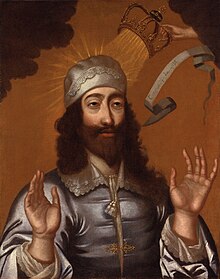King Charles the Martyr | |
|---|---|
 Devotional image of Charles I by unknown artist, early 18th century | |
| King and Martyr | |
| Born | 19 November 1600 Dunfermline Palace, Dunfermline, Scotland |
| Died | 30 January 1649 (aged 48) Whitehall, London, England |
| Venerated in | Anglicanism |
| Canonized | 19 May 1660, Convocations of Canterbury and York by Church of England |
| Major shrine | St George's Chapel, Windsor Castle, England |
| Feast | 30 January |
| Patronage | Society of King Charles the Martyr |
King Charles the Martyr, or Charles, King and Martyr, is a title of Charles I, who was King of England, Scotland and Ireland from 1625 until his execution on 30 January 1649. The title is used by high church Anglicans who regard Charles's execution as a martyrdom. His feast day in the Anglican calendar of saints is 30 January,[1] the anniversary of his execution in 1649. The cult of Charles the Martyr was historically popular with Tories. The observance was one of several "state services" removed in 1859 from the Book of Common Prayer of the Church of England and the Church of Ireland. There remain some churches and parishes dedicated to Charles the Martyr, and his cult is maintained by some Anglo-Catholic societies, including the Society of King Charles the Martyr founded in 1894 and the Royal Martyr Church Union founded in 1906.
- ^ "Worship > Common Worship > The Calendar > Holy Days". Prayer & Worship. Church of England. Retrieved 11 November 2016.
